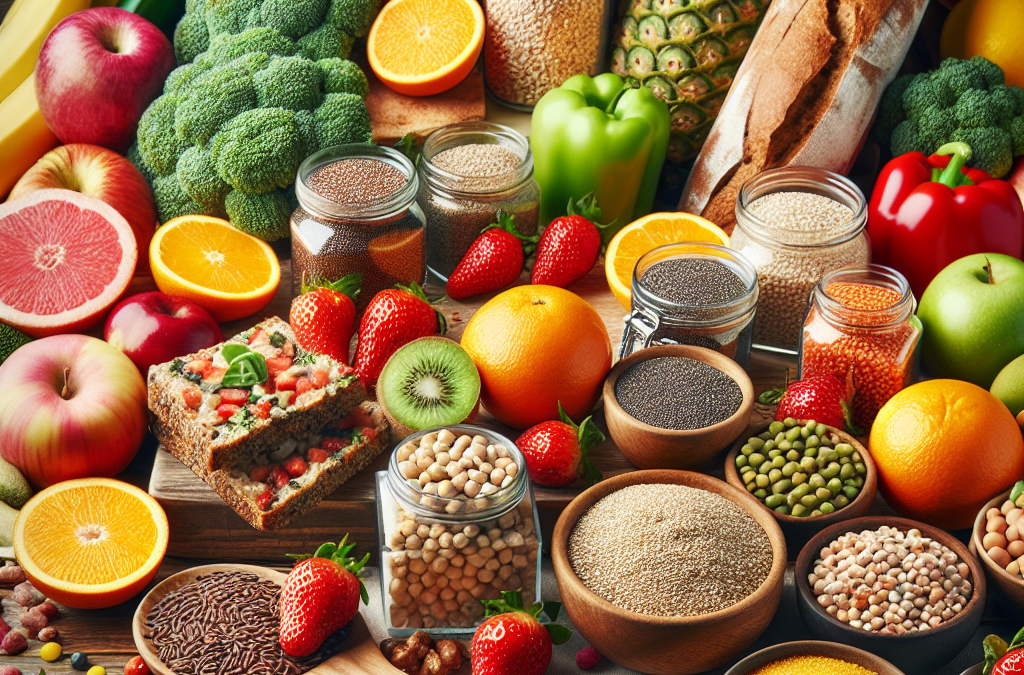Top 4 Semantic Keyword Phrases for Gluten-Free Whole Food Options
- Gluten-Free Whole Food Choices
- Nourishing Gluten-Free Meals
- Healthy Gluten-Free Alternatives
- Wholesome Gluten-Free Ingredients
Gluten-Free Whole Food Choices
Understanding Whole Foods
When I first dove into gluten-free eating, I realized there was a mountain of whole food options waiting to be discovered. Whole foods are basically foods that are minimally processed. They are often packed with nutrients, making them a fantastic choice for anyone navigating a gluten-free lifestyle. Think fruits, vegetables, nuts, and whole grains (like quinoa!).
One of the big benefits is that whole foods tend to be naturally gluten-free. By focusing on these ingredients, you get all the good stuff without the added preservatives and gluten that can sneak into processed foods. I still remember the joy of discovering my local farmer’s market, brimming with fresh produce—it’s like a treasure hunt for healthy foods!
If you’re unsure where to start, load your cart with vibrant veggies and fruits. You can easily whip up a meal by throwing them in a stir-fry or salad. Emphasizing whole foods made my meals not only delicious but also guilt-free.
Exploring Various Options
There are so many gluten-free options out there! It’s like a whole new culinary world opened up for me. For example, I discovered that you can easily substitute traditional pasta with spiralized zucchini or chickpea pasta. Both are fun, filling, and downright tasty!
Additionally, quinoa is my absolute go-to grain. It’s dense, chewy, and packs a protein punch. Whenever I feel like I need something hearty, I whip up a quinoa salad with whatever veggies I have lying around. It’s a bit of a “clean out the fridge” strategy!
Don’t forget legumes! Beans and lentils are not only gluten-free, but they’re also super versatile. You can make soups, stews, or even a delicious bean burger. The possibilities are endless when you embrace whole food choices.
Meal Prep with Whole Foods
One game-changing strategy I’ve picked up is meal prepping with whole foods. It saves time during the week and keeps your eating habits in check. I usually dedicate a Sunday afternoon to cooking a few base ingredients—roasted veggies, grains, proteins like chicken or fish—and then mix and match through the week.
When preparing meals, I like to keep it colorful. A rainbow of veggies not only looks gorgeous but guarantees a variety of nutrients. Plus, if I’m feeling fancy, I can toss in a gluten-free dressing or homemade sauce to elevate the flavor!
The best part? Meal prep means I always have gluten-free, whole food choices at my fingertips. No more last-minute takeout runs—just open the fridge, and voilà!
Nourishing Gluten-Free Meals
Creating Balanced Plates
When I set out to nourish my body with gluten-free meals, I learned that balance is key. I like my plates to contain some protein, healthy fats, and plenty of fiber. This not only keeps me full but also provides lasting energy throughout the day.
A classic example is a bowl filled with brown rice, black beans, avocado, and a sprinkle of cheese. It’s filling and nutrient-dense, plus it’s super easy to whip up! I often experiment by adding spices or other toppings, which adds a delightful twist to a familiar meal.
Don’t overlook breakfast! Start your morning with gluten-free oatmeal or a smoothie packed with greens and fruits—the perfect way to kickstart the day. I love to try new ingredients like almond butter or chia seeds, which not only taste great but also boost the nutrition.
Finding Gluten-Free Recipes
Honestly, I spent quite a bit of time scouring the internet for gluten-free recipes. There’s so much creativity out there! From social media platforms to food blogs, I discovered countless inspiration for nourishing meals.
Sometimes I like to join online gluten-free communities for recipe swaps. It’s so fun to see what others are cooking and find new dishes I can try. One memorable dish I learned to make was a savory gluten-free lasagna using eggplant slices instead of traditional noodles. Seriously, mind blown!
Always keep an open mind when exploring new recipes. You may stumble upon flavors and combos you never thought to try before. I also encourage you to adapt recipes to suit your taste preferences or dietary needs; that’s part of the fun!
Mindful Eating Practices
As I navigated the world of gluten-free eating, I quickly learned that mindfulness plays a huge role in nourishing meals. Taking the time to appreciate the flavors and textures of food makes each bite more enjoyable. Sounds cliché, but it truly transforms your dining experience.
I also started paying attention to my hunger cues. This means eating when I’m genuinely hungry and stopping when I’m satisfied. Kind of revolutionary, right? This allows me to enjoy my meals without feeling deprived.
Sharing meals with friends and family is another mindful practice I’ve embraced. The conversations and laughter over good food create a joyful experience that enhances the entire meal. Plus, it helps me stay on track when I’m eating with others who are supportive of my gluten-free journey.
Healthy Gluten-Free Alternatives
Substituting Common Ingredients
A major part of enjoying a gluten-free lifestyle is knowing how to substitute common ingredients. For instance, I no longer buy regular flour—gluten-free flours have taken over my pantry. Almond flour, coconut flour, and even chickpea flour are great alternatives with unique flavors.
When baking, I’ve found that using a blend of gluten-free flours often yields the best texture. It’s all about experimenting! My latest addiction is a recipe for gluten-free banana bread using almond flour and ground oats. It is delicious!
Get an Amazing Discount on Best Organic SuperFood Product!
I also swap out traditional soy sauce with tamari, which is gluten-free. Trust me, it still packs a flavorful punch in stir-fries and marinades without compromising taste.
Packaged Product Awareness
Beware of packaged foods! It can be a bit tricky since not all labels are created equal. I’ve often found myself getting excited over a gluten-free label, only to later discover it’s loaded with additives.
Reading ingredient lists has become second nature to me. Most of the time, I opt for brands that focus on real ingredients. That’s where I avoid surprises and stick to my goal of maintaining a wholesome diet.
Additionally, I like to explore health food stores, where I often find great gluten-free snacks and alternatives made by conscious brands. It’s a fantastic way to discover new favorites without compromising my health goals.
Experimenting in the Kitchen
Don’t be afraid to experiment! The kitchen has become my playground. I’ve learned that trying out different gluten-free products and recipes can be wildly entertaining. You never know what you’ll end up loving!
Some of my best meals have come from those “what if” moments. Like when I decided to make gluten-free pizza crust with cauliflower. And let me tell you, it was a hit! It’s amazing how many options there are once you think outside the box.
Invite friends over for a cooking night. Trying new recipes together makes it fun, and it’s a great way to lighten the mood around gluten-free cooking. That shared experience is often what I cherish the most!
Wholesome Gluten-Free Ingredients
Building a Gluten-Free Pantry
Let’s talk about building an awesome gluten-free pantry. After a year into my gluten-free journey, I’ve learned which staple ingredients are essential. Having a well-stocked pantry keeps meals exciting and easy to prepare.
Start with grains! Quinoa, rice, and gluten-free oats are fantastic bases for many meals. With a variety of grains on hand, I can whip up anything from hearty breakfast bowls to filling dinners in no time.
Next up, I have a love for seeds and nuts! A stash of chia seeds, flaxseeds, and walnuts always makes for a protein-packed topping or hearty snack. Not to mention, they’re great for adding texture to smoothies.
Fresh Produce is Key
As I mentioned earlier, filling my cart with fresh produce is a crucial part of my cooking. Fruits and vegetables should make up the bulk of what’s in your kitchen. They are not only gluten-free but also bring vibrancy and variety to your meals.
Don’t be afraid to get experimental with your produce choices! Sometimes, the weird-looking veggies can lead to the most interesting dishes. For example, kohlrabi was a new discovery for me—it’s super versatile and adds a lovely crunch to salads!
Always remember to keep your produce organized and rotate what you buy. That way, nothing goes to waste, and your meals stay fresh and exciting.
Herbs and Spices for Flavor
You can’t forget about herbs and spices! They are the secret weapon to elevate your wholesome gluten-free meals. A well-stocked spice rack can turn a simple dish into something extravagant. Think beyond salt and pepper—experiment with cumin, paprika, turmeric, and fresh herbs.
One of my favorite tricks is to make homemade dressings with healthy oils, vinegar, and herbs. They enhance everything from salad to roasted veggies. I always keep a jar of zesty lemon vinaigrette in my fridge, ready to drizzle over my meals.
Don’t underestimate the power of good seasoning. It can transform even the simplest ingredients into a mouthwatering masterpiece. Trust me; it’s all in the details!
Frequently Asked Questions
1. What are the best whole foods for a gluten-free diet?
The best whole foods include fresh fruits and vegetables, lean proteins, nuts, seeds, and whole grains like quinoa, brown rice, and gluten-free oats. Focusing on these foods ensures you’re consuming nutrient-dense meals without added gluten.
2. How can I ensure my meals are balanced?
A balanced meal consists of protein, healthy fats, and fiber. Aim for a combination of these elements in each meal. For instance, a bowl with grilled chicken, leafy greens, avocado, and a side of quinoa is a perfect example!
3. Are gluten-free processed foods safe?
Not all gluten-free processed foods are created equal. Always read labels for hidden additives. It’s best to focus on minimally processed options or prepare meals from scratch using whole foods for optimal health benefits.
4. How can I build a gluten-free pantry?
Start by stocking up on gluten-free grains, seeds, nuts, and a variety of canned or frozen fruits and vegetables. Don’t forget your spices and healthy oils! Trying diverse products will help you get creative in the kitchen.
Get an Amazing Discount on Best Organic SuperFood Product!
Related Content
- The Ultimate Guide to 10 Powerful Nutrient Dense Whole Foods for 2025
- The Ultimate Guide to 10 Effective Whole Food Kitchen Essentials for 2025
- Unlock 7 Secrets of Natural Energy from Fruits (2025 Guide)
- How to Build a Whole Foods Meal Plan for Athletes
- The Benefits of Whole Foods for Managing Chronic Pain




